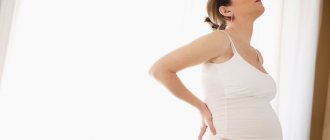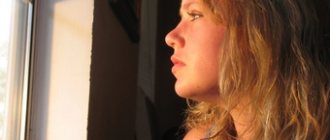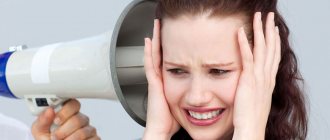An eye tic is a stereotypical, repetitive, involuntary twitching of the muscles around the eye, often preceded by a premonitory impulse. Most tic disorders are genetic or idiopathic in nature, possibly due to a failure to develop inhibitory function within the basal ganglia circuitry that modulates volitional movements.
The term blepharospasm (blepharo means eyelid; spasm is an uncontrolled contraction of a muscle) is applied to abnormal blinking or twitching of the lower eyelid, caused by anything from dry eye syndrome to Tourette's disease and tardive dyskinesia.
Causes of eye tics
When a localized nervous tic occurs, small facial fibers near the eye are affected. Muscle spasm occurs due to a violation of the regulatory process affecting the contractile functions of the eye muscles.
Muscle twitching is caused by:
- Violations in the sphere of emotions - emotional overstrain, fear, neurosis, increased mental stress and other factors. Any stressful condition can cause the development of pathology.
- Blepharospasm, leading to closure of the eyelids. The disease may cause the lower eyelid to twitch.
- Ailments of the central nervous system - multiple sclerosis, disorders of blood flow to the brain, tumors of various etiologies, head injuries, infectious diseases affecting the central nervous system (meningitis, encephalitis).
- Lack of vitamins and microelements - insufficient magnesium and calcium. This can cause spontaneous contractions of various muscle groups (around the eyes, on the phalanges of the fingers, hands, and other muscles).
- A hereditary factor is Tourette syndrome, which manifests itself in childhood and is accompanied by multiple motor tics.
- Hemifacial spasm, which appears due to compression of the facial nerve due to injury, blood artery, inflammation of the nerve and other reasons.
- Drug exposure – side effects from taking antipsychotics, psychostimulants and other psychotropic drugs.
- Overwork, eye fatigue from prolonged strain (for example, embroidery, jewelry making, watching TV, working at the computer, long reading.
- Eye disease - blepharitis, dry eye syndrome, eye irritation of various origins (mechanical, chemical, allergic and others). At the same time, it often hurts the eyes.
- A helminthic infestation that occurs primarily in childhood. This cause of eye tic is extremely rare.
Indications for Botox treatment
The injection of botulinum toxin blocks nerve endings, preventing signal transmission to the muscles, which leads to the elimination of muscle spasms.
In addition, the nerve endings cease to cause acute pain characteristic of neuralgia. Indications for Botox treatment are:
- lack of effect from medications aimed at eliminating nervous tics and treating neuralgia;
- the appearance of spasticity as a result of cerebral hemorrhage or traumatic brain injury;
- tremor of the limbs;
- migraine;
- facial nerve neuropathy;
- muscle hypertonicity after a stroke;
- sharp pain in the temporal part of the head and lower jaw;
- headaches caused by tension in the pericranial muscles;
- constant sharp pain at the site of inflammation of the nerve root.
During attacks of pain due to neuralgia, the doctor may prescribe medications containing strong narcotic substances that negatively affect the patient’s body. In such situations, it is recommended to administer botulinum toxin to eliminate pain and return the patient to a normal lifestyle.
The treatment uses botulinum toxin A, which is currently recommended for the treatment of cerebral palsy from the age of two. The dosage is prescribed depending on the extent of inflammation of the nerve ending, but is rarely more than 300 milligrams.
Botox is indicated for the treatment of Tourette's syndrome, characterized by simple and vocal tics. In more severe cases, drug treatment is required.
This drug has proven itself to be effective in relieving muscle twitching during simple manifestations of nervous tics. If it is characterized by complex movements, its use is possible only if the main nerve ending is detected that triggers the movement of several muscle groups.
Contraindications
Botox is not a panacea and is not always recommended for use. In some situations it can cause negative consequences. Before choosing to inject botulinum toxin into the body, you should make sure there are no contraindications, which include:
- the presence of hypersensitivity to the components of the drug;
- hereditary diseases of the neuromuscular system;
- decreased blood clotting;
- pregnancy and breastfeeding;
- acute inflammatory process occurring in the body;
- exacerbation of somatic diseases;
- history of neurological diseases.
Most contraindications are temporary and associated with the use or intake of antibiotics that can enhance or weaken the effect of Botox. In addition, it is not recommended to administer botulinum toxin to patients prone to the formation of scars; they should choose a medicinal method of treatment.
In general, treatment with botulinum toxin has been carried out for decades and does not cause side effects in patients even with prolonged use of injections.
There is even some advantage over medications taken orally that have a negative effect on internal organs - the kidneys and liver. Botox is applied topically, avoiding intoxication of the body and unpleasant consequences.
Symptoms of a nervous tic
The main manifestations are unexpectedly periodic contractions of the external eye muscle. Muscle twitching cannot be controlled, you cannot get rid of it by volitional effort, it is spontaneous.
The degree of twitching can be different - barely noticeable or pronounced, the amplitude of twitching is also different. It is noted that tics do not occur during sleep. The pathology can be unilateral, affecting the muscles near one eye, or bilateral.
The child's psyche is less stable than that of adults. Therefore, the phenomenon often occurs in children during times of strong emotional stress - the first day of kindergarten in an unfamiliar environment after breaking up with their mother, conflict situations in the family witnessed by the baby, changes in hormonal levels during adolescence. Pediatric neurologists call this childhood tic “first-grader tic.” Increased eye blinking and nervous tics in a child require immediate treatment to avoid worsening the situation.
Botox
Botox Berlin is an integral part of aesthetic medicine. Botox is approved all over the world and has stood the test of time: this youth drug has been officially approved since 1989. Various preparations are presented on the German market under the name “Botox”, such as “Vistabel”, “Dysport”, “Azzalure”, “Xeomin”.
The mechanism of action of botulinum toxin A is based on blocking the release of acetylcholine in the area of the neuromuscular synapse, which causes temporary immobilization of the muscle. Botulinum toxin does not cause nerve damage and does not interfere with the formation of acetylcholine in general. Disturbance in the conduction of neuromuscular impulses, i.e. its blockade causes a change only in functional activity: a temporary stop in the contraction of the facial muscle. As a result of this, the skin over the muscle straightens, facial wrinkles are smoothed out.
By relaxing and smoothing individual facial muscles, Botox injections solve a number of problems. After approximately 3-6 months, this muscle function is restored.
What are drugs based on botulinum toxin A used for?
The therapeutic range of Botox drugs includes about 100 different therapeutic purposes, and the use of Botox in plastic and aesthetic surgery currently occupies one of the first places among all procedures. Even hyaluronic acid began to lose its leadership position.
At the very beginning, Botox preparations were used exclusively to reduce the number and depth of wrinkles. Now, thanks to modern technology for administering the drug in combination with other procedures, it is possible to achieve comprehensive rejuvenation of not only the face, but the neck and décolleté. The art of the doctor lies not only in combating the obvious signs of aging, but also in restoring the structure of the skin to achieve a natural and youthful appearance.
Botox injections (Botox Berlin) in aesthetic and plastic surgery
The main target of Botox injections are expression lines on the upper part of the face. They can appear at the age of 18 simply because you squint in the sun, frown or wrinkle your forehead. The most suitable wrinkles in the upper part of the face are:
These zones have been studied quite well and are the most “resistant” to possible complications.
Thanks to Dr. Kirsten's many years of experience, it has become possible to achieve good results in the treatment of wrinkles in the lower part of the face: in the upper lip area, “perioral wrinkles”, marionette lines extending from the corners of the mouth downwards.
Vertical neck wrinkles, jowls or “bulldog cheeks” also respond well to correction with Botox.
Mesobotox can be used to treat fine wrinkles on the cheeks and décolleté.
Botulinum toxin therapy is indicated for the treatment of facial wrinkles caused by muscle contraction.
Correction of expression lines significantly reduces wrinkles around the eyes, the so-called “crow’s feet”, wrinkles at the corners of the mouth, marionette lines, wrinkles on the forehead and bridge of the nose, as well as wrinkles on the neck and drooping cheeks. Botox injections in the lower part of the face are best combined with hyaluronic acid fillers. During your consultation, Dr. Kirsten will talk about all the possible combinations of Botox procedures that are necessary in your particular case. Efficiency, safety and affordability make Botox injections a popular way to prolong youth. More than 15 years of experience in botulinum toxin injections has allowed Dr. Kirsten to significantly expand the range of Botox applications to the neck and décolleté, where combinations with other rejuvenation methods open up new horizons.
Botox injections for bruxism
Bruxism or odonterism is periodically occurring paroxysmal contractions of the masticatory muscles during sleep, accompanied by clenching of the jaws and unconscious grinding of teeth. Although bruxism is not a disease, teeth grinding can cause a lot of trouble, which especially affects the teeth. Intensive wear of enamel can lead to an increased risk of tooth decay and the formation of caries. One treatment option for teeth grinding while sleeping is to relax the muscles in the mouth and neck, which can be corrected with Botox injections. The effect lasts from 4 to 6-8 months.
Botox injections for hyperhidrosis
About 2% of the population suffers from excessive sweating. The use of botulinum toxin preparations for increased sweating (axillary, palmar, plantar) is the safest, and sometimes the only possible (for example, with plantar hyperhidrosis) method of treating increased sweating. Other methods are ineffective and have significant limitations in application. The action of the drugs is associated with a blockade of the transmission of nerve impulses to the sweat glands, which completely stops the contraction of the sweat glands in the injection area, thereby blocking sweating in the treated area.
What should you pay attention to before the Botox procedure - Botox Berlin?
A week before the procedure, stop taking medications containing aspirin, ibuprofen and vitamin E. If you are taking Marcumar or falytrom (blood thinners), consult your doctor about the possibility of Botox injections. Before your procedure, please tell Dr. Kirsten about any allergies you have. Contraindications for Botox include pregnancy, breastfeeding, and systemic diseases of the nerves and muscles.
How is Botox Berlin performed?
Botox is injected into the areas where wrinkles are located. For this, a very thin short needle is used. Due to the penetration of the drug into the muscles, their facial activity in the treatment area is blocked. The procedure is usually painless; for patients with a high degree of sensitivity, we use anesthetic ointment. After administration of the drug, a cooling bag is applied to the treated area. The duration of the procedure is 10 minutes. Repetition of the course is prescribed individually, taking into account the period of recovery of the patient’s facial expressions.
What should you pay attention to after injection with botulinum toxin A?
Skin care after Botox injection should be carried out as recommended by Dr. Kirsten. You can lead a normal lifestyle immediately after Botox injection, but we advise you to refrain from physical activity with your head tilted down, visiting a solarium, sauna, or exposure to direct sunlight for 10-12 days. Massaging this area is also not recommended.
How long does the effect last and how often can this procedure be repeated?
The effect of the drug appears within the first three to five days after the procedure and reaches its maximum severity after 1-2 weeks. If the effect of the initial treatment is considered insufficient, a correction can be made after 2 weeks during a follow-up visit. Frequent repetition of Botox injections for correction purposes is not recommended due to the development of resistance to Botox (grafting effect). The duration of the effect of Botox reaches 3 months and after 5-6 months the function of facial wrinkles is completely restored. After which the procedure can be repeated. With subsequent injections, the duration of the drug increases to six months.
What complications exist when using botulinum toxin A drugs?
As a rule, side effects after Botox injection are reversible. Dr. Kirsten has extensive experience with Botox. However, as with other medical procedures, complications cannot be ruled out. Complications include swelling, redness, and local pinpoint hemorrhage (hematoma). There is no danger of botulinum toxin poisoning, since the toxic effect occurs at doses a thousand times higher than what you receive when treating wrinkles. Individual intolerance to the drug is possible, which may manifest itself as swelling or allergies.
Also, with an uneven effect of the drug and weakness of the neck muscles, drooping of the eyelids or eyebrows may be observed when Botox is injected in the forehead.
Does the body develop resistance (immunity) against Botox?
For aesthetic purposes, botulinum toxin is used in very small doses and the percentage of development of resistance is quite small, but the possibility of its development still exists. In percentage terms, the development of resistance is about 0.6%. This supposedly happens when unscrupulous medical professionals dilute botulinum toxin with a large amount of saline solution, as a result, the dose of botulinum toxin is small and you are injected with something that is not what you expected and what you paid for. As a result, Botox does not last long.
In our clinic, after administering the drug, Dr. Kirsten gives you a quality guarantee. Two weeks after the procedure, if necessary, you can contact our clinic for a free repeat correction of the treated area.
The effectiveness of Botox for migraines
If the cause of migraine is a spasm of the forehead muscles, then the use of Botox gives good results. Dr. Kirsten will advise you on possible treatments for migraines using botulinum toxin A.
The effectiveness of Botox for nervous tics
Most often, a nervous tic manifests itself in involuntary movements of the muscles of the face and head. The main effect of botulinum therapy is aimed at relaxing the muscles by injecting microdoses of the drug into them. When administered intramuscularly, it blocks neuromuscular transmission. After administration of the drug, the result lasts for about 3-4 months, then the procedure must be repeated.
How much do Botox Berlin injections cost?
Each clinic sets its own pricing policy for Botox injections. Some clinics calculate the price per unit of the drug, others for the treated areas. In our clinic, the cost of injections is calculated based on the area being treated. In addition, this cost includes a control examination with the possible subsequent administration of the required amount of botulinum toxin A. The average cost for one area (for example, frown lines) is 130 Euro. According to German law, doctors do not have the right to publish fixed prices for services on the Internet, since these services are calculated individually, according to GOÄ (Gebührenordnung für Ärzte).
What other procedures can Botox Berlin injections be combined with?
All modern aesthetic procedures, such as mesotherapy, plasma lifting, thermolifting, chemical peeling, laser peeling, thread lifting or fillers can be combined with Botox injections. Dr. Kirsten will explain the sequence of procedures and possible combinations to you during your consultation.
Can a cosmetologist perform Botox injections?
Botulinum toxin preparations themselves are prescription medications and, according to German law, their use can only be carried out by an approved doctor. In addition, to administer Botox, a certain set of knowledge is required: the anatomical structure of muscles, the location of nerves, arteries and veins in the face, neck and décolleté. The drug should be administered by an experienced physician. The consequences of incorrect injections can limit your social activity for several months. We recommend that you carefully consider where and by whom the Botox procedure will be performed.
All aesthetic treatment concepts at Dr. Kirsten's Clinic in Berlin are tailored as closely as possible to your individual needs and characteristics.
Dr. Yuri Kirsten will be happy to take the time to discuss with you all the necessary measures for the treatment and correction of wrinkles using Botox. This consultation is for informational purposes and does not obligate you to further treatment in our clinic.
If you wish, you can schedule a consultation online or by phone.
Traditional treatment
- Treatment of the disease is carried out conservatively; in severe cases, surgical intervention is used. First of all, a favorable psycho-emotional environment is created for the patient. Various psychological trainings, auto-training, and sedatives are used in treatment.
- Primary eye tics of neurological origin are treated with drugs with a sedative effect - “Novo-Passit”, tinctures of medicinal herbs.
- The lack of calcium, which causes twitching of the eye muscles, is compensated by taking calcium gluconate.
- A food menu with plenty of vitamins and mineral components is also recommended. Walking in nature and light exercise in the fresh air have a beneficial effect on the patient's condition.
How is neuralgia treated with Botox in Kyiv?
Before Botox treatment, you should avoid drinking alcohol at least one day before the date of surgery, as well as taking aspirin. You should not engage in physical activity. The botulinum toxin injection procedure does not take much time. First, the doctor numbs the injection site with a special cream. Then the drug is injected with a thin needle two millimeters deep into the skin. The number of injections depends on the affected area, the distance between them is no more than two centimeters.
The procedure lasts on average about half an hour. In this case, from 40 to 300 units of botulinum toxin are injected into the body. The effect is achieved in a couple of days, the maximum – in two weeks. The duration of action of the drug is from four to six months.
As a result of Botox injection in a patient:
- uncontrolled muscle movements stop;
- acute pain goes away;
- motor ability increases.
Folk remedies
In the complex treatment of eye muscle twitching, traditional medicine is used to complement the treatment prescribed by the doctor.
- Motherwort tincture: keep 10 grams of dry motherwort herb or 50 grams of fresh, finely chopped herb in 100 ml of vodka for one and a half weeks without exposure to the sun. Drink 30 drops in the evening, diluted in water.
- Soothing tea: brew a teaspoon of chamomile flowers and lemon balm leaves in a glass of boiling water for 15 minutes. Drink strained tea three times a day.
- Fireweed tea: infuse 12 grams of fireweed flowers (fireweed) in a thermos in half a liter of boiling water for a third of an hour. Drink a glass between meals twice a day, the second dose is advisable before bed (an hour before).
- Tea with oregano, mint and chamomile: has a sedative effect, relieving nervous tension. The product is prepared in a thermos. Mix two tablespoons of mint, oregano, and chamomile flowers. Four tablespoons of the collection are poured with boiling water in the amount of one liter, brewed for one hour. Drink 150 ml of the drink four times a day, sweeten with a teaspoon of honey, after eating.
- With valerian: a strong sedative is prepared from a mixture of 3 parts by weight of oregano, 1 part of crushed valerian root, motherwort herb, two parts of hawthorn berries. 15 grams of the mixture are steamed for a third of an hour, pouring the herbs into half a liter of boiling water. After cooling, the broth is filtered. Consume 100 ml four times a day. Tea gives good results in the treatment of various ailments of the central nervous system, in the treatment of cardiac neuroses, and is effective in the treatment of nervous eye tics in adults.
- Prepare a decoction of sage, yarrow, motherwort: brew 5 grams of each ingredient in 600 ml of boiling water for a third of an hour, using a thermos. Drink like regular tea, adding lemon and honey, three times a day.
- To relieve excess tension: mix 10 grams of heather grass, dried grass, thyme, 5 grams of crushed valerian roots, chicory. Place 3 tablespoons of the mixture in a thermos and fill them with 500 ml of boiling water. The tea is brewed for an hour. Drink 100-150 ml of pure infusion between meals four times a day.
In case of twitching of the eye muscles caused by eye strain or fatigue:
- Close your eyes tightly for 10-15 minutes, giving them rest.
- Apply eye lotions described below.
- Warm up your eyes by blinking quickly for 15-20 seconds, then close your eyelids tightly for 2-3 minutes, resting. Repeat the complex four to five times.
- Open your eyes wide, close your eyes tightly, repeat five to six times. Do it slowly, without much tension.
- Knead the point in the middle of the eyebrow with your fingertips, stimulating the functioning of the nerve. The massage is done softly, smoothly, without strong pressure.
Compresses for contractions of the eye muscles due to eye fatigue or irritation:
- Soak cotton pads in a strong decoction of black tea, squeeze lightly, apply to the eyes, application duration is 10-15 minutes.
- Prepare a chamomile decoction - a tablespoon per 150 ml of boiling water, boil for 3 minutes, cool, filter the composition, and use it in treatment with compresses.
- Make honey water from a tablespoon of beekeeping product and 200 ml of warm water. Soak a gauze swab in the mixture and apply it to the eye sockets for a quarter of an hour.
To calm the nervous system, they use aromatherapy, breathe in compositions that include essential oils of lavender, chamomile, geranium, and cinnamon.
For treatment of muscle twitching around the eyes in children:
- At night, give the child a glass of warm milk with a spoonful of honey.
- Brew tea from mint and chamomile according to the classic recipe (a teaspoon of the mixture per quarter liter of boiling water). Used instead of regular drinks.
- They prepare cranberry juice for children, drinks from rose hips, sea buckthorn, lingonberries, blueberries, adding fresh crumpled mint leaves and lemon to the drinks.
It is extremely important for a child to create an atmosphere of stability and peace, completely eliminating excessive emotions, especially negative ones, from his life.
Treatment
Finding an effective treatment regimen often involves trial and error for each eye tic patient. Treatment with anticholinergics, tranquilizers, and botulinum toxin are the main options. But they are associated with a number of side effects, so it is not surprising that new methods are constantly tested and assessed for safety. Against this background, mosapride is an available option.
- Botulinum neurotoxin injections (examples: Botox and Dysport) work by inhibiting the release of acetylcholine at the neuromuscular junction, which reduces twitching and helps normalize muscle activity. The effects of Botox are temporary and reversible; the injections are typically given every three months and usually provide quick relief from muscle spasms.
- Anticholinergic drugs (trihexyphenidyl, benztropine, biperiden, atropine, procyclidine, diphenhydramine, scopolamine, ethopropazine) have limited benefit due to side effects. It is important to start treatment at the lowest possible dose and slowly escalate it over several weeks or even several months. The most common adverse effects in adults associated with anticholinergic agents include blurred vision, dry mouth, confusion, sedation and memory problems, and additional urinary retention.
- Dopaminergic drugs are used in the treatment of Parkinson's disease and, although dystonia is clearly different, carbidopa/levodopa and other dopamine agonists are sometimes administered to patients with focal dystonia, including blepharospasm.
Surgery is warranted if drug therapy or injections are ineffective for tics, especially when there is a risk of serious side effects.
Blepharospasms in children
In general, when the eye twitches, the causes and treatment in adults are standard. It's more difficult with children. Rapid blinking and eye rolling are common reasons for referral to pediatric ophthalmology and neurologists, but there is little convincing information regarding the natural history of ocular tics without underlying medical conditions (eg, Tourette's syndrome).
Many parents believe that a child's twitching eye is an irritating factor that interferes with learning and other daily activities, and can socially isolate and cause physical discomfort. But it's important to focus on the problem, not the treatment. Children face a lot of stress on their visual system. Tics may subside, and sometimes the right thing to do is simply wait for time to pass and calm the child down rather than treat him with medication.
When prescribing medications, dose titration is used:
- Alpha2-adrenergic agonists are moderately effective for tics. The most commonly used drug in the past was clonidine. Guanfacine is now preferred because it is less sedating and is taken once at bedtime or twice (morning and evening), compared with the three to four doses required for clonidine.
- Drugs that block dopamine receptors are prescribed if alpha2-adrenergic agonists do not provide benefit. These are powerful and predictably effective eye tic suppressants. Although haloperidol, pimozide, and fluphenazine have been shown to be effective in controlled clinical trials, they have fallen out of favor due to frequent side effects, especially sedation, depression, and mental dulling. Children are prescribed atypical antipsychotics (risperidone and aripiprazole), but they are often poorly tolerated and are associated with weight gain and the development of metabolic syndrome.
- In cases where alpha2-agonists and antipsychotics have inadequate response or tolerability problems, focus on other types of medications. Clonazepam and tetrabenazine have a moderate degree of tic suppression.
Cognitive behavioral therapy
Medicines, as a rule, cannot cure nervous tics. At best, pharmacotherapy provides only temporary relief. Because the disease is neurological in nature, doctors are exploring sensorimotor correction so that the brain can repurpose itself and eliminate the dystonic movements.
Correct and dysfunctional coordination coexist simultaneously. This suggests that the body is naturally able to restore proper coordination without drugs. The goal of behavioral therapy is to facilitate a reorganization process known as neuroplasticity. A person learns to avoid self-destructive actions, control his thoughts, behavior, use his imagination and pay attention to the subtle relationships between emotions and movements.
Sensorimotor correction and proprioceptive stimulation allows you to restore function lost due to blepharospasm. The works of Georgy Nikolaevich Sytin are devoted to the neuroplasticity of the brain.
Your doctor may also prescribe antidepressants, but not for tics. They are useful if you have depression that makes your symptoms worse. The drugs have a calming effect, reduce symptoms of anxiety, sadness, and obsessive-compulsive disorder.
Milgamma may be suggested. Known as a natural elixir, it contains B complex vitamins and lidocaine to help stimulate nerve tissue regeneration. The fact that it contains 100 mg of B6 excludes the use of the drug during pregnancy and lactation (excessive amounts of B6 can cause high blood pressure, sleep problems, and rapid heartbeat).
Homeopathic treatment
The goal of homeopathy for any disease is to find a remedy that suits the physical and emotional health of the patient. It is prescribed based on individual symptoms, feelings, mood for treatment, and resonates with the energetic vibrations of the problem. The huge list of homeopathic medicines for the treatment of eye tics includes:
- Agaricus muscarius.
- Cuprum metallicum.
- Argentum nitricum.
Any homeopathic remedy is only a recommendation. Before treatment with it, other factors must be considered, therefore, take the drug only after consultation with a homeopathic doctor.
Alternative treatments for blepharospasm include herbal remedies, hypnosis and acupuncture.








